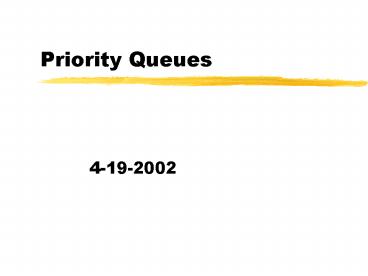Priority Queues - PowerPoint PPT Presentation
Title:
Priority Queues
Description:
Priority Queues 4-19-2002 Opening Discussion What did we talk about last class? Do you have any questions about the assignments? The designs for assignment #6 are ... – PowerPoint PPT presentation
Number of Views:152
Avg rating:3.0/5.0
Title: Priority Queues
1
Priority Queues
- 4-19-2002
2
Opening Discussion
- What did we talk about last class?
- Do you have any questions about the assignments?
The designs for assignment 6 are supposed to be
due on Monday, but since I wont be here you can
have that extended until Wednesday. - What is a priority queue and what do we use them
for?
3
Motivation
- Consider the following problems.
- You are writing software to control what jobs get
sent to a printer. Different jobs have different
priorities so that things that matter more should
get printed first. How do you set this up in an
efficient way? - You are writing some type of event handling
system. Every so often you are given a task and
a time when it needs to be started. You need to
start them in the proper order.
4
Operations and Requirements
- For these types of problems we need a container
with only three operations. One is to be able to
get the minimum or maximum element. The others
are to be able to add new elements and remove the
minimum. - The idea would be O(1) for both operations, but
that generally isnt attainable. We can get O(1)
for finding and O(log n) for the adding/removing.
5
Heaps
- The data structure we want to use to achieve this
is called a heap. A heap is a tree type
structure, but it isnt sorted in the same way as
the binary trees we discussed. Instead it uses
the Heap-Order Property where all the nodes
below a given node have values higher than it. - Recursively we can just say, the root is the
minimum value in the tree.
6
Complete Trees as Arrays
- When a tree is complete we can easily represent
it as an array. In a complete tree, the left
most nodes in a generation get their children
first, and nodes get a left child before a right
child. - Note that for a binary tree, the path to a leaf
can be expressed as a binary number. If we
prefix it with a 1 we get a unique encoding where
the first element is 1. This also allows up to
quickly find parents.
7
Inserting to a Heap
- To insert into a binary heap, we put a bubble
node at the next open space and let it move up
the heap until it moves into place. - At each step it gets swapped with a value greater
than it so the heap-order property is maintained. - This operation takes O(log n) time because the
heap is a complete tree.
8
Removing from a Heap
- To remove the smallest element we simply make the
bubble node at the top and this time the last
element in the heap is what will wind up filling
it. We let it sink down through the tree. At
each step we swap it with the smaller of the two
children assuming that it is larger than them.
If it isnt it can stop there.
9
Minute Essay
- I want you to draw the heaps that result from
adding the following numbers into an empty heap
then removing two of them. 4,8,6,2,3,7 - There will be no class on Monday. On Wednesday
my flight arrives at 830am so there is a
non-zero chance I could miss class that day as
well. I will call the office if Im running late
so someone will come in here to let you know.































